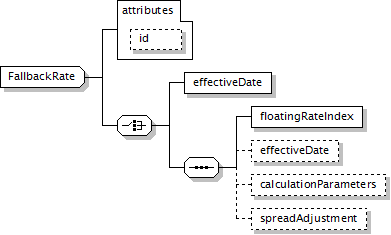complexType "FallbackRate"
Namespace: |
|
Content: |
|
Defined: |
|
Includes: |
|
Used: |
|
XML Representation Summary |
<... |
|
|
|
> |
|
|
</...> |
Content Model Elements (5):
-
All Direct / Indirect Based Elements (2):
-
Annotation
Defines a fallback rate, which is a rate to be used in place of a publish term rate (such as an ibor rate) when that term rate ceases to be usable, whether because it ceases to be published or is deemed non-representative by regulator.
XML Source (w/o annotations (6); see within schema source)
<xsd:choice>
<xsd:element name="effectiveDate" type="xsd:date"/>
<xsd:sequence>
</xsd:sequence>
</xsd:choice>
<xsd:attribute name="id" type="xsd:ID" use="optional"/>
</xsd:complexType>
|
Attribute Detail (all declarations; defined within this component only; 1/1)
 id
id-
Type: |
xsd:ID, predefined |
Use: |
optional |
XML Source (see within schema source)
<xsd:attribute name="id" type="xsd:ID" use="optional"/>
|
Content Element Detail (all declarations; defined within this component only; 5/5)
-
This provides a representation of the approximate value of the fallback rate, i.e. a calculated rate that quite closely mimics the value anticipated to be published by the fallback rate administrator (once the spread adjustment is added).
XML Source (w/o annotations (1); see within schema source)
-
Type: |
xsd:date, predefined, simple content |
The Applicable Fallback Effective Date, as defined in the 2021 ISDA Interest Rate Derivatives Definitions, Section 8.5.4. The date upon which the fallback rate becomes effective. This means that any rate observation for that date or for any subsequent date would use the fallback rate rather than the originally defined rate. This date will typically immediately follow the cessation of publication of the original term rate but could occur before that (e.g. if the original rate is deemed non-representative prior to cessation of publication). If the effective date occurs within a calculation period with multiple rate observations (because of averaging), observations prior to the effective date will use the original floating rate index, and observations on or after the effective date will use the fallback rate.
XML Source (w/o annotations (1); see within schema source)
-
Type: |
xsd:date, predefined, simple content |
The Applicable Fallback Effective Date, as defined in the 2021 ISDA Interest Rate Derivatives Definitions, Section 8.5.4. The date upon which the fallback rate becomes effective. This means that any rate observation for that date or for any subsequent date would use the fallback rate rather than the originally defined rate. This date will typically immediately follow the cessation of publication of the original term rate but could occur before that (e.g. if the original rate is deemed non-representative prior to cessation of publication). If the effective date occurs within a calculation period with multiple rate observations (because of averaging), observations prior to the effective date will use the original floating rate index, and observations on or after the effective date will use the fallback rate.
XML Source (w/o annotations (1); see within schema source)
<xsd:element minOccurs="0" name="effectiveDate" type="xsd:date"/>
|
-
The benchmark rate used for computing the fallback rate. Typically this will be a risk-free overnight rate.
Simple Content
maxLength: |
255
|
minLength: |
0
|
XML Source (w/o annotations (1); see within schema source)
-
Type: |
xsd:decimal, predefined, simple content |
An amount to be added to the calculated value before subsequent use, in order to more closely replicate the original term rate, by adjusting for the economic or credit spread between risk-free rates and risky term rates.
XML Source (w/o annotations (1); see within schema source)

